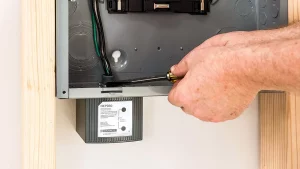Choosing the right surge protector is essential for safeguarding electronic devices and optimizing energy efficiency. Key factors include joule ratings, clamping voltage, and outlet availability. Understanding these features can greatly impact device longevity and performance. Additionally, consideration of warranties and maintenance practices plays a critical role in ensuring lasting protection. The intricacies of these elements will determine the most effective surge protector for specific needs. What should one prioritize in their selection process?
Key Takeaways
- Look for a surge protector with a high joule rating for better energy absorption and device protection.
- Choose a surge protector with a low clamping voltage for enhanced safety against voltage spikes.
- Ensure the number of outlets meets your needs to avoid overloading and accommodate all devices.
- Check for features like USB ports and indicator lights for added convenience and monitoring.
- Regularly inspect your surge protector for damage and avoid overloading to maintain efficiency and safety.
Understanding Surge Protectors: What They Do and Why You Need One
Although many consumers may overlook the importance of surge protectors, understanding their function is essential for safeguarding electronic devices. Surge protectors serve to absorb voltage spikes, diverting excess electrical energy away from connected devices. These voltage spikes can occur due to various factors, including lightning strikes, power outages, or fluctuations in the electrical grid. By limiting the amount of voltage that reaches sensitive electronics, surge protectors help prevent damage, ensuring longevity and functionality of devices. Additionally, they contribute to energy efficiency by stabilizing the power supply, reducing waste. For consumers who value both device safety and efficiency, knowing how to choose the best surge protector is critical in establishing a secure and reliable electronic environment.
Key Features to Consider When Choosing a Surge Protector
When selecting a surge protector, several key features warrant careful consideration to guarantee peak protection and functionality. To begin with, the joule rating indicates the device’s energy absorption capacity; higher ratings typically signify better protection. In addition, response time is critical; a shorter response time guarantees that devices are shielded from surges more quickly. Thirdly, the number of outlets should accommodate all devices without overloading the protector. Additionally, consider features such as indicator lights for surge protection status and built-in circuit breakers for safety. Finally, warranty and equipment coverage can provide added peace of mind. By evaluating these features, consumers can make informed decisions on how to choose the best surge protector for their needs, enhancing both safety and energy efficiency.

Evaluating Surge Protector Ratings for Optimal Performance
How can consumers effectively evaluate surge protector ratings to guarantee peak performance? Understanding the key metrics is vital. The Joule rating indicates the energy absorption capacity, with higher values signifying better protection levels. Additionally, the clamping voltage reveals the voltage threshold that triggers protection; lower figures offer enhanced safety for devices. Response time is another significant factor, as quicker activation minimizes potential damage during surges. Moreover, evaluating the number of outlets and built-in features, such as USB ports, can enhance convenience. By analyzing these specifications, consumers can make informed decisions. Ultimately, selecting a surge protector with superior ratings guarantees not only device safety but also contributes to overall energy efficiency. This process is essential in choosing the best surge protector for modern needs.
Assessing the Right Surge Protector for Your Devices
What factors should consumers consider when evaluating the right surge protector for their devices? First, they must assess the total wattage of connected devices, ensuring the surge protector can handle the load without risk of overload. Next, consumers should examine the joule rating, which indicates the energy absorption capacity; higher ratings equate to better protection. Additionally, the number of outlets is essential for accommodating multiple devices. Features such as USB ports may enhance convenience, while response time is important for determining protection effectiveness against surges. Finally, consumers should consider the warranty period, reflecting the manufacturer’s confidence in product performance. By understanding these elements, consumers can make informed choices on how to choose the best surge protector for their needs.
Tips for Proper Surge Protector Usage and Maintenance
After evaluating the right surge protector, understanding its usage and maintenance becomes essential for ensuring peak performance and longevity. Regularly inspect the surge protector for visible damage, such as frayed cords or burnt outlets, which can compromise safety. It is advisable to keep the surge protector in a well-ventilated area to prevent overheating. Users should avoid overloading the device by adhering to its wattage limits and not daisy-chaining multiple protectors. Additionally, unplugging the surge protector during severe storms can provide extra protection against power surges. Following these guidelines not only enhances the functionality of the surge protector but also promotes a communal responsibility for device safety. This awareness fosters a sense of belonging among users dedicated to safeguarding their electronic investments.
Frequently Asked Questions
Can Surge Protectors Prevent Damage From Lightning Strikes?
Surge protectors can mitigate damage from lightning strikes by diverting excess voltage. However, their effectiveness varies; higher-rated protectors offer better protection. Users should verify their surge protectors meet specific standards for maximum safety and reliability.
How Often Should I Replace My Surge Protector?
Surge protectors should generally be replaced every three to five years, or sooner if they show signs of wear or after a significant surge event. Regular assessment guarantees ongoing protection against electrical surges for connected devices.
Do Surge Protectors Work for High-Powered Devices?
Surge protectors can effectively safeguard high-powered devices if they possess adequate joule ratings and response times. However, compatibility with specific device requirements is essential for ensuring ideal performance and protection against voltage spikes.
Can I Use Multiple Surge Protectors Together?
Using multiple surge protectors together can lead to potential overloads and reduced efficacy. Each unit’s capacity is limited; consequently, combining them may compromise protection. It is advisable to select a single, adequately rated surge protector for ideal safety.
Are There Surge Protectors Specifically for Outdoor Use?
Surge protectors designed for outdoor use feature weather-resistant casings and enhanced durability. These models guarantee protection against environmental factors, providing safety for devices exposed to elements, thereby maximizing overall device longevity and efficiency in outdoor settings.
Conclusion
To summarize, selecting the ideal surge protector involves careful consideration of key features such as joule rating, clamping voltage, and outlet capacity. A higher joule rating signifies superior energy absorption, while a low clamping voltage enhances responsiveness to voltage spikes. Additionally, the inclusion of USB ports and a robust warranty can further elevate convenience and reliability. By adhering to recommended usage and maintenance practices, users can guarantee their devices remain protected and energy-efficient over time.
You May Also Like:






